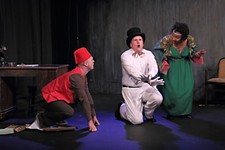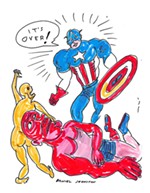Elytra: New Synthesis
Local Arts Reviews
Reviewed by Robert Faires, Fri., Sept. 8, 2000
The Vortex,
through September 30
For ages, writers have expounded metaphorically on the war between head and heart. In Elytra, Chad Salvata's latest fusion of ancient myth and far-futuristic imagery, the cyber-opera composer dispenses with metaphors and makes the war literal. His heroines are a quartet of female Insect-Angels who inhabit the drifting corpse of GoldSun, the cyborg emperor from The X & Y Trilogy's first work The Black Blood, and who are charged with reviving it and creating a new race of mortals to fuel its machinery. But each dwells in a different part of the GoldSun body -- one in Brain, one in Heart, one in Liver, one in Sex -- which eventually causes discord. They split into factions, and Malthus, the inhabitant of GoldSun Brain, battles it out with Ovovia, the inhabitant of GoldSun Heart.
As anyone who has witnessed one of the previously staged cyber-operas by Salvata can imagine, the path to this confrontation winds through a maze of fantastic settings, surreal creatures, weird names, lavishly imagined but sometimes maddening mythologies, hypnotic electronic music, periodically unintelligible lyrics, opulent outfits, dazzling lighting, and fiercely committed performances. Here, a figure named Pupawhorycon dances in and out of the scene, sometimes observing, sometimes manipulating the Insect-Angels. The Insect-Angel Circus at one point relates the song of the Camera Snail, which she heard while in the GoldSun Liver. Ovovia seduces Circus into performing the ritual of Divine Merging, which illuminates the Lampyria and engages the Engines of Heaven, and all four Elytra use the Angelic Urinal Funnel to relieve themselves in the Lily of the Flesh, thus spawning Heaven's race of mortal Ants. The meaning behind some of these creations can be, as is generally the case with Salvata's works, a challenge to puzzle out (if indeed we are meant to). This time out, however, Salvata is working on a smaller canvas, and it gives Elytra a tighter focus, a more direct throughline, and a stronger sense of his direction. He's clearly dealing with issues of death and regeneration, creation, power and control, and even when his treatment of them winds through dense landscapes, we can glimpse the road. In fact, sometimes Salvata keeps it clear as day, as in the delightful creation of the Ants segment, which results in a race of horrid creatures such as the Christian Ant, the Rock Star Ant, the Ball Player Ant, and the deathly poisonous Critic Ant (!).
If anything, the clarity of the drama, conflicts, and symbolism only enhances our appreciation of the production elements in a Salvata cyber-opera. The elaborate and stimulating visual and aural designs that have been the hallmark of the Vortex stagings of The Black Blood, Panoptikon, and Triskelion are no less impressive here, but by virtue of our deeper involvement in the story being told they take us further into Salvata's cybernetic cosmos. We appreciate them for what they tell us about these figures and their battles. Ann Marie Gordon's scenic work -- a garden of oversized foliage with weird accents -- feels all the more unearthly; Jason Amato's lighting -- shafts of smoky white light and lurid color -- feels more eerie; Kari Perkins' costumes -- form-fitting leather jumpsuits and dresses in bold hues, Baroque headgear mimicking insect heads and antennae -- feel more alien. The performances of the five actresses make their characters feel more inhuman.
Once again, director Bonnie Cullum deserves credit for orchestrating these strange elements into a compelling whole. Salvata is fortunate to have a director such as Cullum to realize this unique form so thoroughly. With Elytra, the artists of the Vortex Repertory Company and Ethos achieve a new level in integrating cyber-opera style and story. It may not be the synthesis of heart and head, but it approaches the synthesis of human and machine at the heart of Salvata's cybernetic aesthetic.










